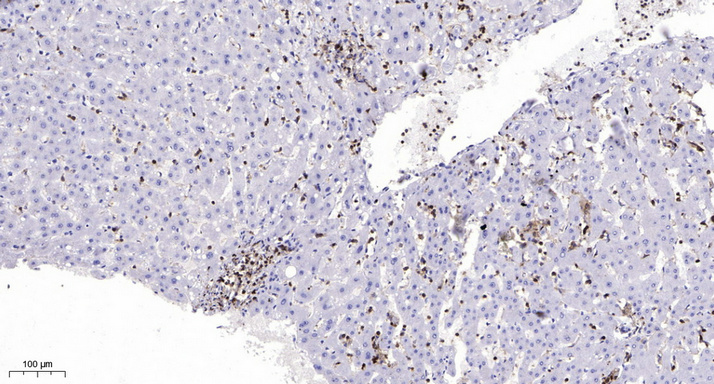Mre11 (Phospho Ser676) rabbit pAb
- Catalog No.:YP1407
- Applications:WB;ELISA;IHC
- Reactivity:Human;Rat;Mouse;
- Target:
- MRE11
- Fields:
- >>Homologous recombination;>>Non-homologous end-joining;>>Cellular senescence
- Gene Name:
- MRE11A HNGS1 MRE11
- Protein Name:
- Mre11 (Ser676)
- Human Gene Id:
- 4361
- Human Swiss Prot No:
- P49959
- Mouse Gene Id:
- 17535
- Mouse Swiss Prot No:
- Q61216
- Rat Gene Id:
- 64046
- Rat Swiss Prot No:
- Q9JIM0
- Immunogen:
- Synthesized phosho peptide around human Mre11 (Ser676)
- Specificity:
- This antibody detects endogenous levels of Human Mre11 (phospho-Ser676)
- Formulation:
- Liquid in PBS containing 50% glycerol, 0.5% BSA and 0.02% sodium azide.
- Source:
- Polyclonal, Rabbit,IgG
- Dilution:
- WB 1:500-2000;IHC 1:50-300; ELISA 2000-20000
- Purification:
- The antibody was affinity-purified from rabbit serum by affinity-chromatography using specific immunogen.
- Concentration:
- 1 mg/ml
- Storage Stability:
- -15°C to -25°C/1 year(Do not lower than -25°C)
- Other Name:
- Double-strand break repair protein MRE11A (Meiotic recombination 11 homolog 1) (MRE11 homolog 1) (Meiotic recombination 11 homolog A) (MRE11 homolog A)
- Observed Band(KD):
- 80kD
- Background:
- This gene encodes a nuclear protein involved in homologous recombination, telomere length maintenance, and DNA double-strand break repair. By itself, the protein has 3' to 5' exonuclease activity and endonuclease activity. The protein forms a complex with the RAD50 homolog; this complex is required for nonhomologous joining of DNA ends and possesses increased single-stranded DNA endonuclease and 3' to 5' exonuclease activities. In conjunction with a DNA ligase, this protein promotes the joining of noncomplementary ends in vitro using short homologies near the ends of the DNA fragments. This gene has a pseudogene on chromosome 3. Alternative splicing of this gene results in two transcript variants encoding different isoforms. [provided by RefSeq, Jul 2008],
- Function:
- cofactor:Manganese.,disease:Defects in MRE11A are a cause of ataxia telangiectasia-like disorder (ATLD) [MIM:604391]. ATLD is a disease with the same clinical feature than ataxia-telangiectasia but with a somewhat milder clinical course.,disease:Defects in MRE11A may be a cause of breast cancer.,function:Component of the MRN complex, which plays a central role in double-strand break (DSB) repair, DNA recombination, maintenance of telomere integrity and meiosis. The complex possesses single-strand endonuclease activity and double-strand-specific 3'-5' exonuclease activity, which are provided by MRE11A. RAD50 may be required to bind DNA ends and hold them in close proximity. This could facilitate searches for short or long regions of sequence homology in the recombining DNA templates, and may also stimulate the activity of DNA ligases and/or restrict the nuclease activity of MRE11A to prev
- Subcellular Location:
- Nucleus . Chromosome, telomere . Chromosome . Localizes to discrete nuclear foci after treatment with genotoxic agents. .
- Expression:
- Bladder,Brain,Epithelium,Lung,
- June 19-2018
- WESTERN IMMUNOBLOTTING PROTOCOL
- June 19-2018
- IMMUNOHISTOCHEMISTRY-PARAFFIN PROTOCOL
- June 19-2018
- IMMUNOFLUORESCENCE PROTOCOL
- September 08-2020
- FLOW-CYTOMEYRT-PROTOCOL
- May 20-2022
- Cell-Based ELISA│解您多样本WB检测之困扰
- July 13-2018
- CELL-BASED-ELISA-PROTOCOL-FOR-ACETYL-PROTEIN
- July 13-2018
- CELL-BASED-ELISA-PROTOCOL-FOR-PHOSPHO-PROTEIN
- July 13-2018
- Antibody-FAQs
- Products Images

- Immunohistochemical analysis of paraffin-embedded human liver cancer. 1, Antibody was diluted at 1:200(4° overnight). 2, Tris-EDTA,pH9.0 was used for antigen retrieval. 3,Secondary antibody was diluted at 1:200(room temperature, 45min).

- Western Blot analysis of Hela A431 cell ,using primary antibody at 1:1000 dilution. Secondary antibody(catalog#:RS23920) was diluted at 1:10000



